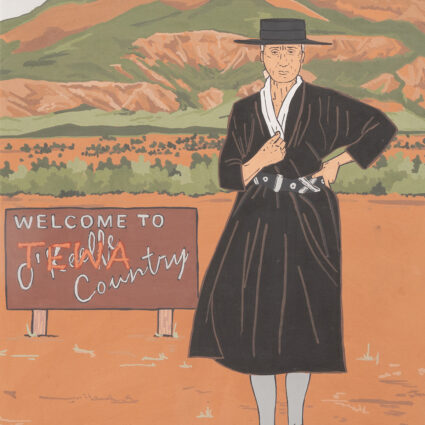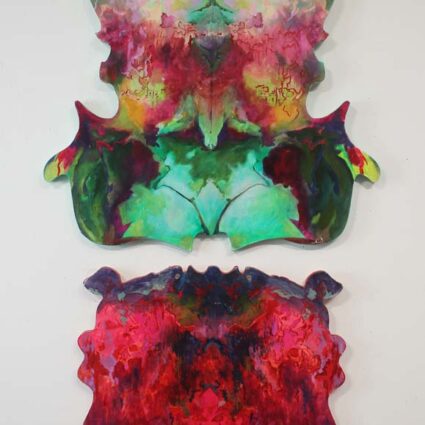The Ucross Artist Residency Program near Sheridan, Wyoming, supports artists in an obligation-free program on a working ranch that’s all about creativity, bonding, good eating, and resting.
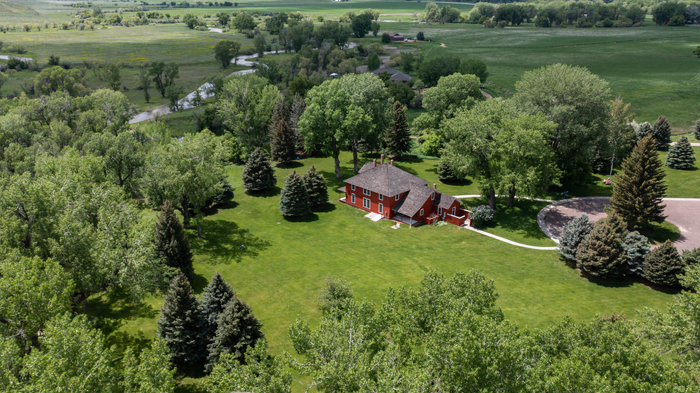
It’s a temperate early May afternoon in Ucross, Wyoming, and Deb Olin Unferth unwinds inside a writer’s studio after a day working on a new novel. The room is noiseless and spacious, with a desk, bookshelves, and a couch ripe for afternoon naps.
Unferth only arrived at the Ucross Residency Program a few days ago, yet she already feels at home away from her busy Austin, Texas, home.
“I have a great life [in Austin], but it’s nice to come here to the quiet to write,” says Unferth, an English department professor at the University of Texas at Austin and author of six books of fiction and nonfiction.
About three-quarters of a mile across Ucross’s sprawling campus, a sublime 20,000-acre working ranch in the foothills of the Bighorn Mountains, Hilary Brace works on a series of meticulous, Baroque-style drawings that depict imaginary weather events. The back door to the 400-square-foot space is open, revealing wispy clouds and a flowing Clear Creek. It’s an almost ridiculously perfect scene.
“[Ucross] has thought of every detail,” says Brace of Santa Barbara, California. “To the nth degree.” The artist says that the residency’s setup has allowed her to make headway on her drawing series.
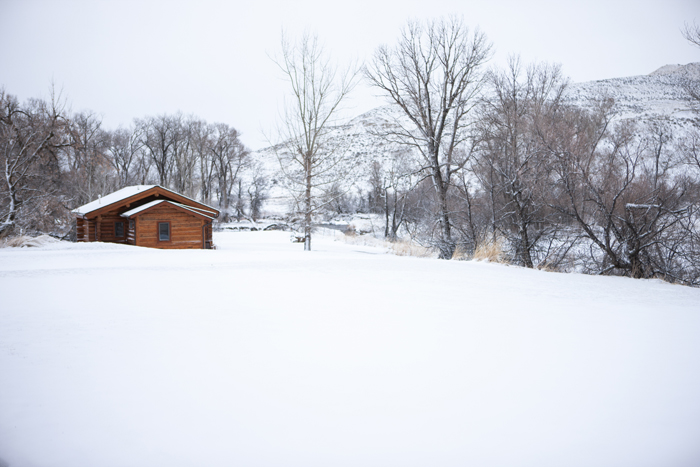
The Ucross Artist Residency is the ultimate in artist hospitality. The program, which last month began its fortieth year of operation, gives visual artists, writers, performance artists, choreographers, interdisciplinary artists, composers and sound artists, and collaborative teams an obligation-free stay of two to six weeks.
Artists can come to the pastoral grounds—which residents often say are integral to fueling their creative practices—to create, mingle with fellow creatives, eat delicious home-cooked food, and sometimes hold impromptu dance parties inside of a rustic cabin that was once home to a big-game hunter.
Others travel to northern Wyoming to do nothing. And that’s totally cool with Ucross.
“There are residents who will just decompress and sleep for two weeks because they need that in their life for their creative process,” says William Belcher, president and executive director of Ucross since April 2022. “We embrace that.”
Ucross has given opportunities to thousands of creatives. The site, located south of small-town Sheridan, includes living spaces, writer’s quarters, a house with studios for visual artists, a dance studio, two composers’ cabins complete with instruments, and a ranch house with a library. Native American fellows receive a $2,000 award and a $1,000 stipend; all other general residencies include a $1,000 stipend.
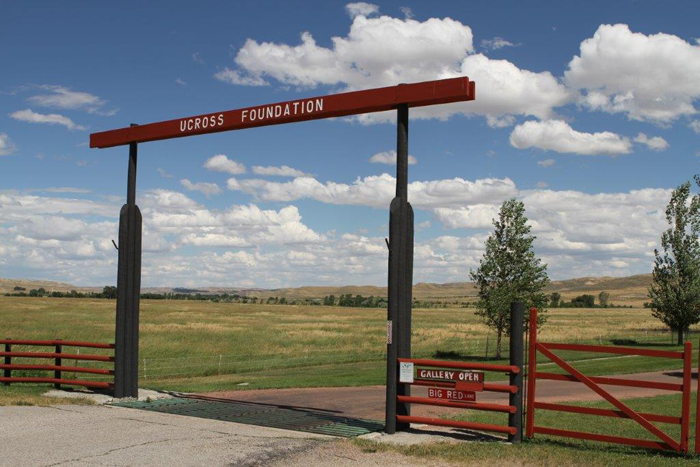
Even with an esteemed reputation, Ucross continues to expand its inclusivity and scope. A robust alumni network follows Ucross residents whenever they return home and onto their next career stages. And when former residents are invited back for various events, the main topic is often the food, which has obtained greatest-of-all-time status.
“I can’t talk enough about how important it is—at the end of the day, when you’ve been working—to not have to think about making dinner and how special that was for the artists at Ucross,” says Teresa Baker (Mandan/Hidatsa), a 2020 Ucross Native American Fellow for Visual Artists.
S. Erin Batiste, a Black poet and visual artist based in Brooklyn, has hung her collages and text-based work on one wall of her writer’s studio.
As part of her artistic practice and her Louisiana Creole ancestry, Batiste traveled to New Orleans to comb through a historical archive containing Bertillon card booking photos of 118 Black women from the late 1890s to the 1920s. Batiste says that the women, ranging from age fourteen to forties, were jailed for many reasons, including sex work, petty theft, and simply being “dangerous and suspicious persons.”
“It may have been the only photo taken in their lives,” says Batiste, who has called the series Major Arcana. “[The project] is reclamation instead of erasure.”
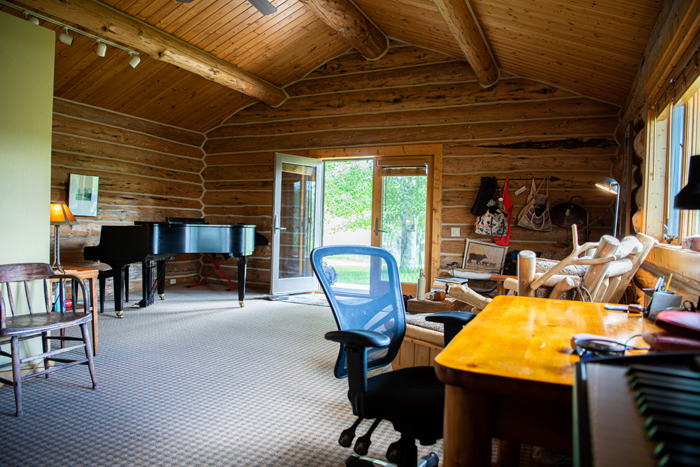
On only her fifth full day at the residency, Batiste—the recipient of a Toi Derricotte Residency at Ucross, a literary fellowship that provides creative support to Black poets—has already formed bonds. She and a few of the departing residents danced to synth pop and ’90s Miami rap inside Buck’s Cabin. The recreational space is also a time capsule: a hunter named Buck once lived here, and the space still houses his keepsakes.
The ranch became an artist retreat in 1983. That wasn’t the original plan.
In 1981, Raymond Plank, co-founder of Apache Corporation, created Ucross Foundation to establish a conference center that would be a destination for corporate executives and stakeholders. When that didn’t pan out, Plank’s wife at the time, Heather Plank, persuaded her husband to adapt the property into an artist residency.
“[Raymond Plank] didn’t have any special affiliation with art, but he was an innovator and creative thinker and appreciated creativity in others,” says Belcher. “He liked to bring people together and create a little friction or clashing.
“Ucross is a crossroads. He wanted to bring hunters, corporate energy executives, Indigenous communities, artists, and all these folks together, and then just kind of stir the pot and see what happened,” Belcher continues about Plank, who passed away in 2018 at the age of ninety-six. “For us [as an artist residency], it’s similar to when composers, dancers, and visual artists come together and talk about their creative processes.”
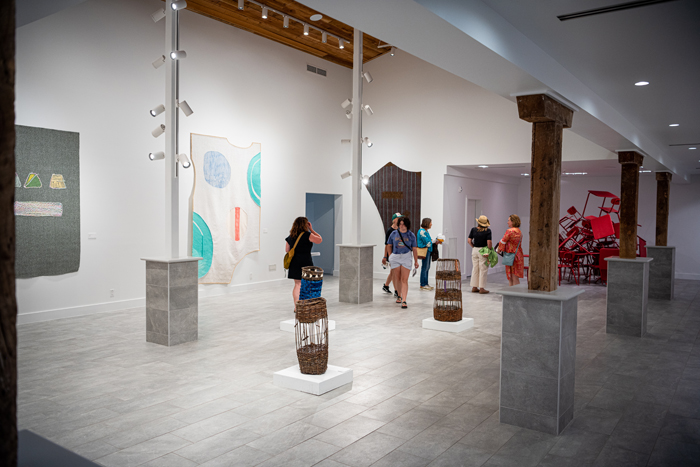
Belcher says that he is confronted “all of the time” about Ucross Foundation’s ties to a mega-corporation that specializes in oil and gas exploration, drilling, and fracking.
“It’s never a straight line,” says Belcher. “[Plank] came to Wyoming looking for a place for drilling operations. But when he came through the valley, he saw how beautiful the land is and also how run-down the ranch was, so he wanted to restore it.”
“[Plank] believed in conservation and the land and land stewardship principles,” adds Belcher, who says Plank established an American West land management program between the Forest School at Yale University and the Ucross High Plains Stewardship Initiative. “But I always acknowledge that there are other things involved like carbon credits and tax benefits. It wasn’t just for conservation. Still, Raymond thought it was important to give back, and Ucross was one of the ways he did that.”
The residency increased its national profile, especially as a writers’ haven, after former Ucross resident and author Annie Proulx thanked Ucross in the acknowledgments of her 1993 Pulitzer Prize-winning novel The Shipping News. Other Ucross alumni include MacArthur “Genius Grant” recipients like composer Jason Moran, National Book Award prize holders such as Colson Whitehead, and Academy, Tony, Emmy, and Golden Globe winners.
But Ucross isn’t just for big names. Approximately 2,600 artists have gone through the program, which hosts an average of fifty-five artists in each eighteen-week fall and spring session. (Ucross also holds a smaller, special invitation session in the summer.)
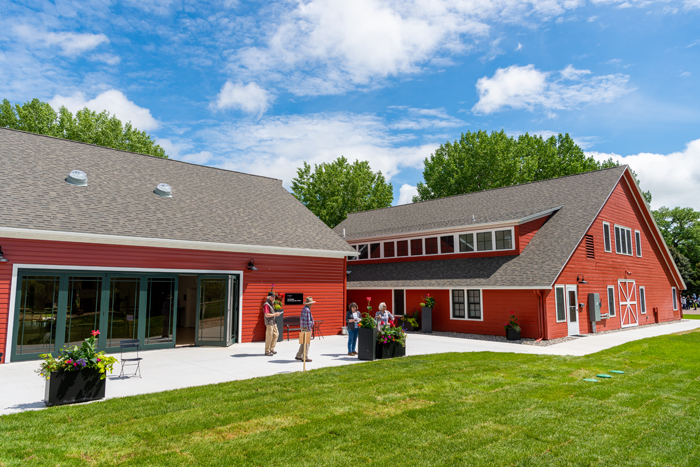
It’s standard for artists to gather in the Ucross School House building to eat family-style meals prepared by Cindy Brooks, who’s viewed as a regional deity. In 2022, she published, to critical acclaim, The Ucross Cookbook: Cooking for Artists on a Wyoming Ranch. (Earlier this year, Brooks announced her retirement. Ucross recently hired Jackie Vitale, a former chef-in-residence at the Rauschenberg Residency on Captiva Island, Florida.)
“The artists often talk about how the food and the experience of gathering around the table is so special,” Belcher explains. “They feel like their art is valued and that they as artists are valued in a way that they don’t feel when they’re going around the world. When they’re here, they feel like VIPs and the center of the world.”
Ucross occupies traditional unceded lands of the Cheyenne, Crow, and Lakota nations. In an ongoing effort to engage with Native American communities, the organization established fellowships for Native American visual artists in 2018 and for Native American writers in 2020. Ucross also works with local Native communities, Indigenous leaders, Native curators and teachers, and has added Native representation to its board and advisory councils.
Four recipients of the 2020-21 Ucross fellowship for Native American visual artists were invited to present work in Field Guide—an exhibition organized by Andrea Hanley (Navajo), chief curator at the Wheelwright Museum of the American Indian in Santa Fe—including the aforementioned Teresa Baker, Anthony Hudson (Confederated Tribes of Grand Ronde, Siletz), Jessica Mehta (Cherokee Nation), and Eliza Naranjo Morse (Santa Clara Pueblo).
In early May, Baker, Mehta, Morse, and Hanley presented an energetic artist talk at Sheridan College. Later in the evening, inside the Ucross Art Gallery in the historic Big Red Barn—recently refurbished and transformed into a streamlined two-story contemporary art space—a well-attended Field Guide reception allowed the artists, curator, Ucross residents, journalists, and community members to talk shop during a laid-back, congenial hangout.
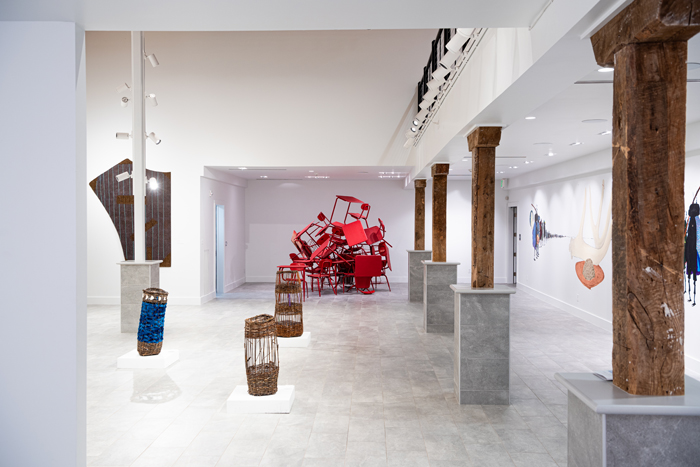
Ucross’s network extends beyond artists with studio practices.
“I didn’t even go to Ucross for a residency but [Ucross] has changed my life,” says Hanley, who is also a member of Ucross’s national advisory council and has served on the selection committee.
About Field Guide, her second curatorial project for Ucross, Hanley says, “They offered me another really wonderful opportunity to work with some important Native artists and to think about larger ideas around their practices.”
During the height of the pandemic, San Francisco–based artist Michele Foyer snatched up boxes of wedding invitation paper—after all, most nuptials were canceled during the pandemic’s height, which led to a surplus of the specialty paper.
Fast forward to May 2023 at Ucross: Foyer is experimenting with a series of light-reactive, sculptural works of paper that she paints, arranges, collages, and floats off the wall.
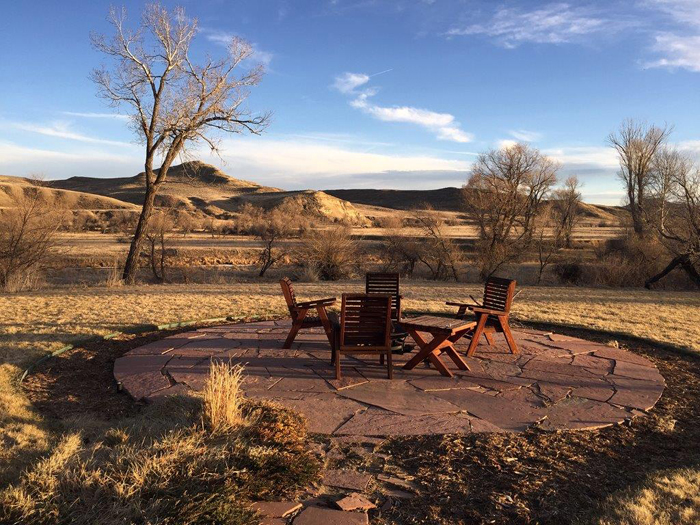
The residency has allowed Foyer to focus on a form of mark-making where the colors of her compositions aren’t subservient to one another. “I want the art to move all different ways in a piece with no dominance or hierarchy. I don’t know how to do that yet,” says Foyer, who’s motivated by the challenge, especially now that she’s at Ucross for the next few weeks.
Ucross, run by a nineteen-person staff, is able to support itself because of a $24 million endowment. An odd arrangement allows Ucross to lease the 20,000 acres of ranch land to Apache Foundation, which subleases to Bauer Land and Livestock, a holistic ranching company that raises sheep, cattle, and other livestock on the Ucross property. The endowment and lease payment contributes to about half of Ucross Foundation’s $2.6 million annual budget. Fundraising, grants, special events, partnership funds, and community support comprise the other half.
Belcher estimates that 80 percent of Ucross’s marketing is word of mouth. It seems to be working—for the 2023 session, Ucross experienced a 35 percent spike in applicants (1,152 total). In the years prior to the pandemic, the number hovered in the 700-750 range.
Residents cycle through every two weeks and there’s always a group of ten artists living and working on the grounds.
“We’ve had this discussion year after year about whether we grow or stay at ten [residents at a time], and we’re fully committed to capping the amount at ten,” says Belcher. “We’ve received advice… that if you start to get to twelve or fourteen, cliques start to happen. We think that if we were to grow, the bonding that the artists talk about would be damaged.”
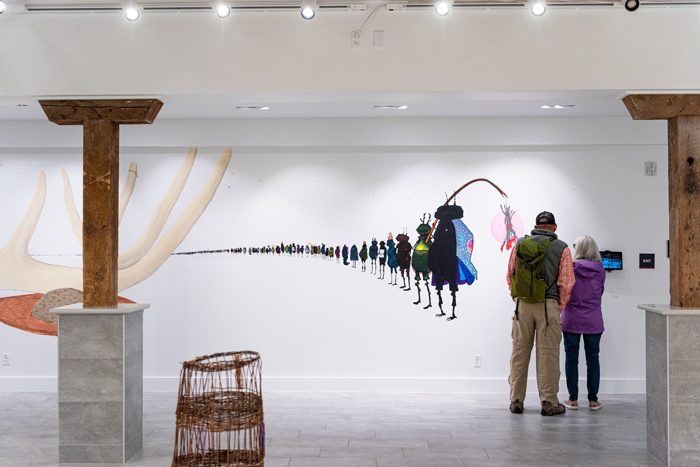
While the program’s numbers can be quantified, there’s a deeper, unexplainable mystique to Ucross that can’t be qualified. During the Sheridan College artist talk and Field Guide reception, curator Hanley and the exhibiting artists spoke poetically about how the land’s spirit connected to their artmaking.
Belcher, a published novelist himself, agrees. “Is it the beauty and the view? Is it that time feels like it slows down here? Is it that you’re maybe coming from a metropolitan area and you’re perceiving or receiving sensory details differently? What is it about the land?
“Every time I feel like I get an answer, it shifts,” Belcher continues. “There’s something else underneath it all about this particular place of the High Plains and the Bighorns that connects to the creative process.”
Back in Unferth’s writer’s studio, the author talks about the hurdles she’s encountered while working on her newest novel.
The whole thing has been challenging. She’s tried to write the book three times: once before the pandemic, again during lockdown, and at present. Unferth says that she typically doesn’t work in this way, and that the unfamiliar territory is a bit uncomfortable. But the sense of mental freedom that’s baked into Ucross is relieving some of the pressure.
It also helps, when her brain is fried, that she can walk over to the School House to heat up homemade food that’s been left in the fridge. Maybe, later on, there will be another spontaneous dance party inside Buck’s Cabin. Or, if the couch is calling her name, she can slide open a studio window to let in the fresh air and fall asleep to Ucross’s soundtrack of peace and quiet.
More Regional Artist Residencies at a Glance
There are a number of dynamite area residencies that give significant support to artists in fostering and encouraging creativity. Here are a few to note:
Bemis Center Artist-in-Residence
Omaha, Nebraska
bemiscenter.org
Bemis pays residents a $1,250 monthly stipend and is a dreamboat for sculptors and ceramic artists—there’s a 9,000-square-foot facility dedicated to creatives working in these media—and for experimental sound artists, as Bemis boasts a 1,000-square-foot sound studio for rehearsing and recording.
Breck Create’s Artist-in-Residence Program
Breckenridge, Colorado
breckcreate.org
Artists at Breck Create spend two to four months living and working in the picturesque Breckenridge Arts District, where they can attend on-campus classes and open studios for free. Resident artists receive a $600 biweekly stipend.
Roswell Artist in Residence
Roswell, New Mexico
rair.org
RAiR gives artists “the gift of time” and a $1,100 monthly stipend (plus $100 per month for a spouse or partner and each child living with the grantee) via a one-year residency where artists work in a spacious studio and live with their families in a furnished apartment.
Tulsa Artist Fellowship
Tulsa, Oklahoma
tulsaartistfellowship.org
This residency is the longest of the bunch, as artists are asked to realize a project during a three-year commitment living and working in Tulsa’s Arts or Greenwood districts. The artist fees are also no joke: $150,000 over three award years in addition to $12,000 for yearly housing, $1,200 in yearly health and wellness, $1,200 in yearly studio assistance, and a one-time $1,500 relocation allowance.

